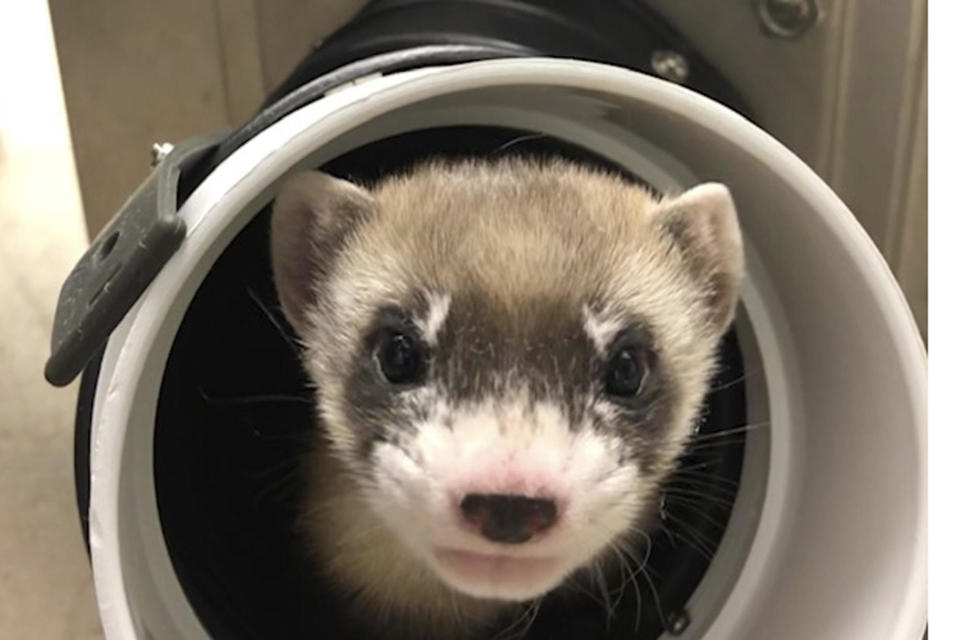2-month-old ferret clone marks milestone in animal conservation
Elizabeth Ann is just 2 months old, but her extraordinary life is already making history. This black-footed ferret is a clone of an animal that died more than 30 years ago, and she is the first successful clone of any endangered species native to the U.S.
The U.S. Fish and Wildlife Service said on Thursday that Elizabeth Ann's birth on December 10 was a "bold step forward" in the efforts to increase the genetic diversity and disease resistance of black-footed ferrets, which were once thought to be extinct. The species has been listed as endangered since 1967, and is North America's only native ferret.

"Although this research is preliminary, it is the first cloning of a native endangered species in North America, and it provides a promising tool for continued efforts to conserve the black-footed ferret," said Noreen Walsh, director of the U.S. Fish and Wildlife Service's Mountain-Prairie Region.
Additional footage of the lovely Elizabeth Anne. 🙂 pic.twitter.com/fz7HnwyI1F
— US Fish and Wildlife (@USFWSMtnPrairie) February 18, 2021
The only living black-footed ferrets today are descendants of seven individuals, the Fish and Wildlife Service said, which creates "unique genetic challenges" in recovery and conservation efforts. A lack of genetic diversity can cause a species to become more susceptible to diseases and genetic abnormalities and can decrease the chances of successful reproduction.
Willa, the ferret from which Elizabeth Ann was cloned, was among the last wild species to be found and captured in 1981, the Fish and Wildlife Service said. She, among others found at that time, was put into a captive breeding program in the Wyoming Game and Fish Department in an attempt to rescue the species.
Willa has no living descendants, according to the Fish and Wildlife Service, but in 1988, her genes and tissue samples were preserved in the San Diego Zoo Global's Frozen Zoo.
Related video: Behind The Dodo's heartwarming animal videos
A loss of habitat and prey are the biggest threats to this ferret species, according to the Fish and Wildlife Service. When in the wild in the U.S. grasslands, the species heavily relies on prairie dogs for survival. Along with prairie dogs making up roughly 90% of their diet, the black-footed ferrets also rely on prairie dog burrows for shelter.
Along with making Elizabeth Ann's life possible, Willa's cells possess "three times more unique variations than the living population" of black-footed ferrets. If Elizabeth Ann is able to reproduce, this means her offspring will add more diversity to the black-footed ferret population, potentially making the species more resistant to current and future natural challenges.
Walsh said that maintaining and increasing the species' wild populations, as well as preserving a suitable habitat, is "essential" for the species to fully recover.
"Successful genetic cloning does not diminish the importance of addressing habitat-based threats to the species or the Service's focus on addressing habitat conservation and management to recover black-footed ferrets," Walsh said.
Genetic cloning is a new tool that could pave the way for conserving endangered and threatened species by supplementing traditional and proven measures such as habitat protection, captive breeding, disease control, invasive species management, and wild population surveys.
— US Fish and Wildlife (@USFWSMtnPrairie) February 18, 2021
Elizabeth Ann will not be released into the wild. Instead, she will be the subject of additional research as scientists attempt to produce additional black-footed ferret clones.
Ryan Phelan, the executive director of wildlife conservation organization Revive and Restore, which partnered with the Fish and Wildlife Service, said Willa's genomics "revealed the genetic value that Willa could bring to her species."
"It was a commitment to seeing this species survive that has led to the successful birth of Elizabeth Ann. To see her now thriving ushers in a new era for her species and for conservation-dependent species everywhere," Phelan said. "She is a win for biodiversity and for genetic rescue."
Why does Texas have an independent power grid?
Doctor weighs in on Pfizer's COVID vaccine trial for pregnant women

